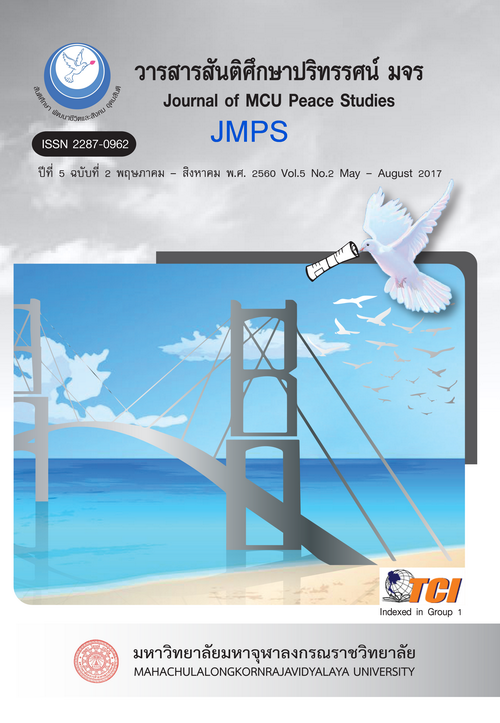The Integration of Zen’s Technics to Withhold the Anusaya
Main Article Content
บทคัดย่อ
From the result of study on the technics of Zen’s way to withhold Anusaya it is found that Zen Nikãya is of an influence from the teachings is of Yogãcãra which generally mentions that Anusaya is the seed of Avījjã which is Bīja (biological order) lying in the depth called consciousness storage which is of an effect on the mind in the level of Manas i.e. the dual thought which causes the thought and the action attached to “self” as “I” and “mine.” Thus, Zen has an aim to find the technical method or the device in the practice that either a monk or a villager can do it in daily life with the easy technics and not the complexed method for the wake-up of realization with full mindfulness at the present moment, in other way called the watering of mindful the seed of mindfulness to flourish beautifully to replace the Avījjã seed. Thus, the action, the thought and the Anusaya would be upheld by the mindful way being aimed to point directly to the students own minds or that of the disciples who cause many times of the mental experience to be able to develop the attainment of Satori.
Moreover, the result of studying Buddhadhammas to uphold Anusaya as said in Theravãda Buddhist doctrine with the aim to study the upholding of Anusaya of bad Puthujana, a wordly person and really bad Puthujana who always makes himself and the people around who are in suffering and in unhappiness owing to the inability to control his or her bodily and verbal action composing of misconduct in accordance with Pañcasīla or the five precepts in the level of Vītikkamakilessa, thus are unable to control his or her thought in the level of Pariyutthānakilessa i.e. the desire, the anger and the ignorance owing to inability to withhold the latent Anusaya i.e. Santānānusaya and Arammanānusayakilessa. The researcher has studied only the three kinds of Anusaya i.e. 1) Rāgānusaya 2) Patigānusaya and 3) Avijjānusaya by studying the Buddhist principles which are the rival to these three kinds of Anusaya and also to study the Buddha’s technics to uphold or eradicate Anusayas in His teachings which are suitable for Caritas (the intrinsic natures) and the disciples Anusayas who are still Puthujanas at the Buddha’s time. The study has covered all other environmental factors i.e. the natural way of meditation, Luang Pu Dul’s way of watching the mind and Luang Phor Tien’s dynamic meditation watching the movement of the body and the mind.
The result of integrating Zen’s technics to Theravada Buddhist principles and the Buddha’s technics in his teaching as well as the interview of the Buddhist scholars to uphold Anusaya of a bad Puthujana and a really bad Puthujana so as to develop himself to be a Kalyāna Puthujana acquires the Buddhist principle at the level of Sila being called Sila and Cāga which are no. 1 and no 2 in 5 Āraya Vutthis being in accordance with Ovādapātimokkha. In the other way , it is so called the core teaching of Buddhism that is not to do any evil.
As for the Buddhist principle at the level of Samādhi, the result of integrating the Zen’s technics to Theravāda Buddhist principles and the Buddha’s technics in His teaching as well as the interview of the Buddhist scholars for those Puthujana villagers to follow Satthā which is no. 3 in Āraya Vutthi 5 by developing meditation and Saddhā to eradicate Nivarana (the five hindrances) at the level of Vikkhambhanapahāna which can withhold Santānānusaya by leading his life in accordance with Ovādapātimokkha that is to cultivate the goodness.
As for the Buddhist principle at the level of Paññā, the result of integrating Zen’s technics to Theravada Buddhist principles and the Buddha’s technics in His teaching as well as the interview of the Buddhist scholars for those Puthujana villagers to follow Paññā and Bahusacca (or Suta) which are no. 4 and no. 5 in 5 Āraya Vutthis by contemplating Tilakkhana at the level of Tadañkapahāna which can withhold Ārammanānusaya by leading his life in accordance with Ovādapātimokkha that is to purify the mind. At the level of Paññā, all three kinds of Anusaya i.e. Rāgānusaya, Patighānusaya and Avijjānusaya which could be upholden.
Article Details
ทัศนะและความคิดเห็นที่ปรากฏในบทความในวารสาร ถือเป็นความรับผิดชอบของผู้เขียนบทความนั้น และไม่ถือเป็นทัศนะและความรับผิดชอบของกองบรรณาธิการ ยินยอมว่าบทความเป็นลิขสิทธิ์ของวารสาร

